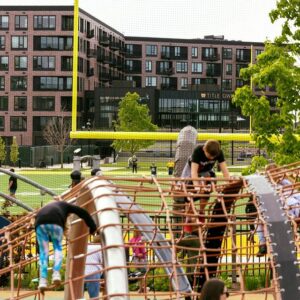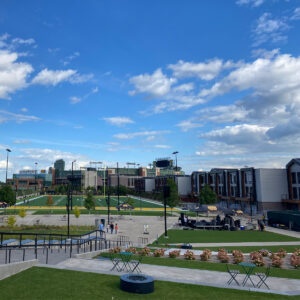Now In Ninth Year, Program’s 5,144 Trees Will Provide $24.8 Million In Lifetime Benefits
The Green Bay Packers, Essity and Green Bay Packaging Inc., marked another successful year of the “First Downs for Trees” program Monday by planting a tree at Titletown, just west of Lambeau Field.
What is First Down for Trees?
Essity and Green Bay Packaging, Inc., the program’s corporate partners, once again provided funds to result in the planting of 437 trees in 16 Brown County communities. One of the Packers’ Green Team initiatives, the program donates trees to participating Brown County communities based on the number of first downs scored by the Packers in the previous season.
Who Provides the Trees?
Two nurseries, Meacham Nursery and Leaves Inspired, provided the trees this year. A combination of elm, maple, lilac, oak, honey locust and flowering crab trees are among the species that were planted.
Who Receives the Trees?
Receiving trees this year were Allouez, Ashwaubenon, Bellevue, Brown County, De Pere, Green Bay, Hobart, Howard, Lawrence, Ledgeview, Morrison, Oneida Tribe, Pulaski, Scott, Suamico and Wrightstown.
Who Else Supports the Program?
The program receives administrative support from the Wisconsin Department of Natural Resources and Wisconsin Public Service.
Who Spoke at the Event?
Packers alumni Gerry Ellis and Johnnie Gray joined Murphy at the planting event, as well as Wisconsin Lieutenant Governor Mandela Barnes and DNR Secretary Preston Cole. In addition, Carrie Schuster, Essity brand communications manager, sustainability/services/hygiene, and Jeff Walch, Green Bay Packaging vice president of corporate container board sales, made remarks on behalf of the program.
Why Was First Downs for Trees Created?
First Downs for Trees complements the team’s recycling and landfill diversion programs at Lambeau Field by targeting the carbon emitted by the Packers’ air charters to road games, which is approximately 450 tons in a year.
What Impact Has First Downs for Trees Had?
Since 2011, 5,144 trees have been planted through the program, providing total lifetime benefits of $24.8 million through stormwater runoff reduction, CO2 reduction, energy savings, air quality improvement and property value increase. Over their lifetime, the tree benefits exceed the costs of planting and care, representing a 300 percent return on investment. Tree benefits increase over time, highlighting the importance of not only planting trees, but of providing ongoing maintenance and protection.






